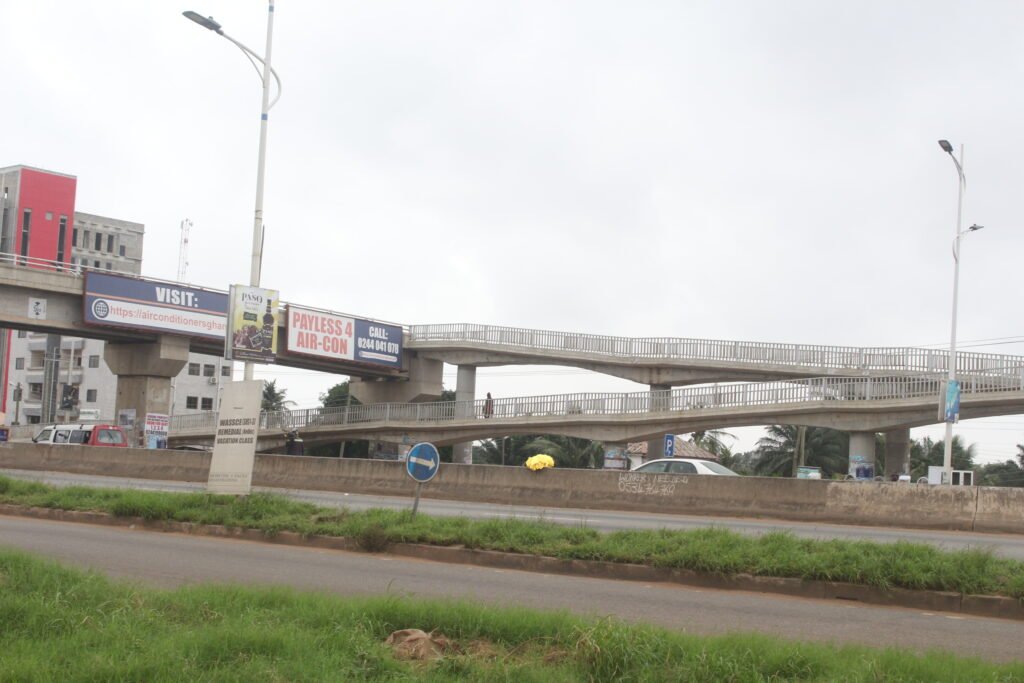ARTICLE AD
Foot bridges constructed along the Madina-Adentan highway in Accra to promote road safety are not being used by many pedestrians.
The bridges completed in 2019 have become ‘white elephants’ as pedestrians continue to cross the busy highway directly, disregarding road safety regulations.
During a visit to the area last Friday, the Ghanaian Times observed that both young and old pedestrians were risking their lives while crossing the road.

 •
The abandoned bridge. Inset: The bridges turned into a refuse dump Photos: Anita Nyarko-Yirenkyi
•
The abandoned bridge. Inset: The bridges turned into a refuse dump Photos: Anita Nyarko-Yirenkyi

Some sections of fencing installed to prevent direct road crossings had been cut through, allowing pedestrians to cross immediately after alighting from vehicles.
The bridges have also become havens for substance abusers while some pedestrians had turned the bridges into refuse dumps and a place of convenience.
The disregard for the footbridges comes about five years after they were completed following agitation from pedestrians who called on the government to build footbridges in order to reduce the number of persons who die from crossing the highway.
This was after a 22-year-old student of the West Africa Senior High School in Adentan was killed by a speeding taxi while crossing the highway in front of her school.
Residents interviewed by the Ghanaian Times assigned various reasons for not using the bridges.
Irene Dadzie, a trader, cited the length of the bridges as an excuse.
She said “Using the roads takes less time. I also avoid the bridges at night due to fears of being attacked or robbed by the people hanging around there.”
Akua Morrison, a student, said it was faster to cross the road directly especially when she is carrying load.
She said she was usually careful when crossing the road.
However, Ama Dansua, a plantain chips seller, said despite the length, she uses the bridges “for my own protection”.
Some drivers expressed serious concerns about the situation.
Mr Kweku Agyeman noted that, “We have to be extra careful to avoid hitting pedestrians crossing the roads. It’s very dangerous.”
Another driver, Mr Johnson Appiah, highlighted the increased risk at night due to a lack of street lighting.
He called for increased police presence to deter unsafe crossing behaviour.
When contacted, a police officer from the Adentan Motor Traffic and Transport Department (MTTD), speaking on condition of anonymity, stated that despite the risky behaviour, no recent pedestrian knockdowns had been recorded in the area.
The officer said, to address the situation, there was increased police presence in the areas with support by the Adentan District Assembly.
“In some cases, we arrest recalcitrant pedestrians and educate them on road traffic laws,” the source explained, and cited the Road Traffic Act and LI 2180, which mandate the use of pedestrian bridges where available.
The source said MTTD also conducts periodic sensitisation programme to educate commuters and traders on the dangers of not using the bridges.
The Adentan Municipal Chief Executive, Mr Ebenezer Doku, told the Ghanaian Times that the Assembly was aware of the situation and was embarking on public education towards attitudinal change.
He said the Assembly would get more taskforce personnel to boost the manpower to ensure safer roads and collaborate with the Police Service to prevent attacks from recalcitrant pedestrians on their men.
The Greater Accra Regional Director of the National Road Safety Authority (NRSA), Ms Catherine Hamilton, said the Authority was aware of the worrying trend at the area.
She said officials from the NRSA collaborated with the Police Service and the District Assembly to arrest recalcitrant pedestrians to deter others but the sustainability of that strategy is a problem.
She said despite public awareness campaigns some commuters have refused, while others verbally assault the personnel.
Ms Hamilton advised the pedestrians to use the footbridges to save lives.
Efforts to get a comment from the Public Relations Officer of the Ghana Highways Authority (GHA), Mr Cecil Wentum, were unsuccessful.
As of the time of filing this report he had not returned this reporter’s calls.
BY ANITA NYARKO-YIRENKYI

 2 months ago
16
2 months ago
16 

